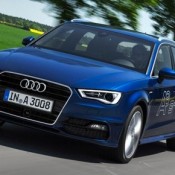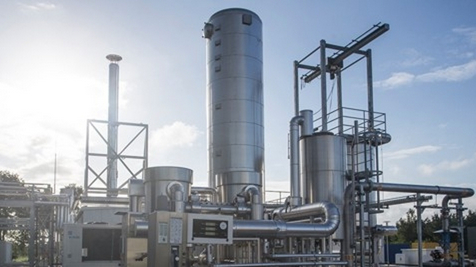From Nuremberg to Munich - no sweat - it's stylish and fast tooling down the German autobahn. But the new Audi A3 Sportback g-tron feels special because it's a whole CO2-neutral energy ecosystem. Even more impressive, the g-tron might even become the lynchpin to the world's first nationwide electricity storage network.

Born in Fukushima
Although no one knew it at the time, the g-tron was born in the aftermath of the disaster in Fukushima, when Angela Merkel shut down eight of her country's 17 nuclear reactors. At that moment the German government committed itself to the Energiewende - whether it was ready or not - which means eventually supplying at least 80% of its electricity by solar, wind, and other renewable energy sources by 2050. But the future is already bumping up against the first rule of the grid: a balance between supply and demand must be maintained at all times.
So far, solar and wind production have ramped up so quickly that records are broken weekly. For example, on June 9, a national holiday in Germany, solar power peaked at 23 GW, equal to 50.6% of total demand. Of course, at the same time, too much power can make the grid dysfunctional, causing wholesale prices to go negative and forcing utilities to pay the grid to take their electricity.
This has taken a toll, which, according to the Economist, has been devastating. At their peak in 2008, the top 20 energy utilities were worth roughly $1.3 trillion. In just six years they're worth less than half that amount. In 2008 the top ten European utilities all had credit ratings of A or better. Now only five do.
It's become obvious that grid-wide storage could tame the volatility. Unfortunately, other than a small fraction of pumped hydro, there's no way to smooth out the peaks and valleys of renewable intermittency, or the mismatch between constant base load power and either the afternoon solar peak or the late evening wind peak.
The growing problem becomes daunting. Some researchers estimate that by 2050 generating 80% of electricity from renewables will require 30,000 gigawatt-hours of storage. That dwarfs the 40 gigawatt-hours of pumped-water storage in Germany now, which renewables can generate in one hour on a sunny and windy day.
Audi's e-gas storage solution
Fortunately, Audi has developed a renewable energy storage system that the company thinks could serve as a model for the whole country. For the past year, the company has been running a prototype plant in Werlte, Germany, which converts 6MW of excess wind energy to make a fuel called e-gas with technology developed by Stuttgart, Germany-based ETOGAS GmbH.
Stephan Rieke, ETOGAS's chief customer officer, says that the amount of excess renewable energy in Germany has grown from 150 gigawatt-hours per year to 1,000 gigawatt-hours per year. "That's electricity that we could use for nothing."

The plant works in two steps: first electrolysis and then methanation. In the first step, the plant's three electrolyzers use polymer electrolyte membranes to break water down into oxygen and hydrogen.
Although Audi hopes that hydrogen will power fuel-cell-powered cars in the future, for now, however, with no infrastructure, a second process was added: in a methanation unit the hydrogen is reacted with CO2 to produce synthetic methane, or Audi e-gas, which is virtually identical to typical natural gas and can be distributed - and stored - by the existing German natural gas network to be later pumped as compressed natural gas (CNG) in fueling stations.
Efficient energy use is an integral part of the plant's design. Waste heat thrown off during methanation is sent in a closed-loop to an adjacent biogas plant and used as process energy, boosting the supply of CO required for methanation.
The Audi e-gas plant produces about 1,000 metric tons of e-gas a year, while binding 2,800 metric tons of CO2. It's the same amount of CO2 that a forest of over 220,000 trees absorbs in a year, according to Audi. It will power 1,500 new Audi A3 Sportback g-trons 9,320.57 miles every year. All in all, that adds up to more than 18,700,000 climate-neutral miles driven every year.
A nationwide consensus
Audi's e-gas project extends well beyond its own rebranding and even the German auto industry, and shows how large amounts of wind and solar energy could be saved by changing it into methane gas and storing it in the nationwide natural gas pipeline network, where it can also be converted back to electricity. As part of an emerging national consensus, other German utilities and manufacturers have built their own power-to-gas (P2G) projects, although they've focused on hydrogen.
Researchers say that there's one drawback to the P2G process.Whether it's synthetic gas or hydrogen production, it's plagued by inefficiency. By creating the gas and then using it to create electricity, two thirds of the energy is lost. However many German researchers feel that it's the only option that offers the necessary scale at the moment.
So when the Germans discuss "long-term storage," they're talking about storing hydrogen or e-gas for weeks, months, or longer and will trade inefficiency for long duration. So while soaking up excess renewable energy to produce e-gas is an important facet of the project. Storing it, transporting it nationwide, and converting it back into electricity is the ultimate value of the process.


